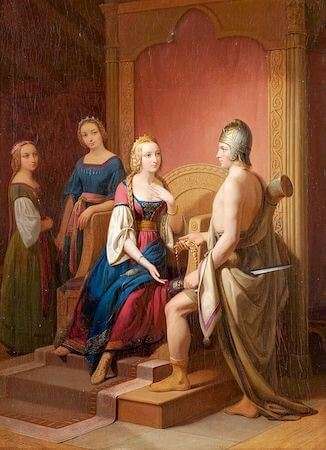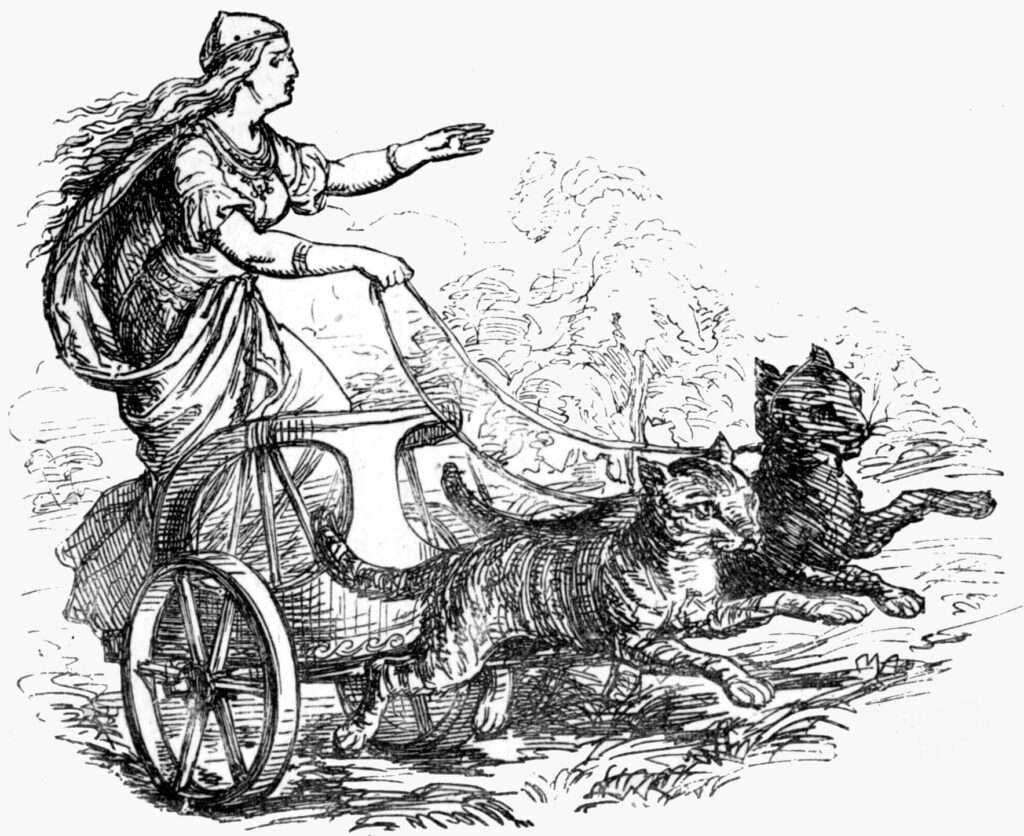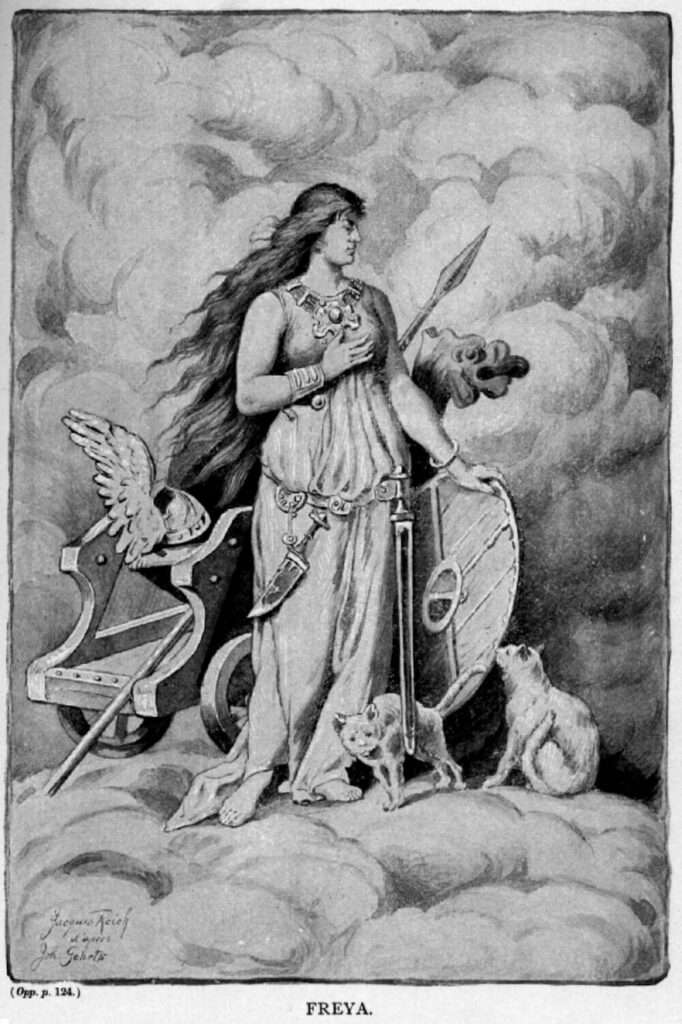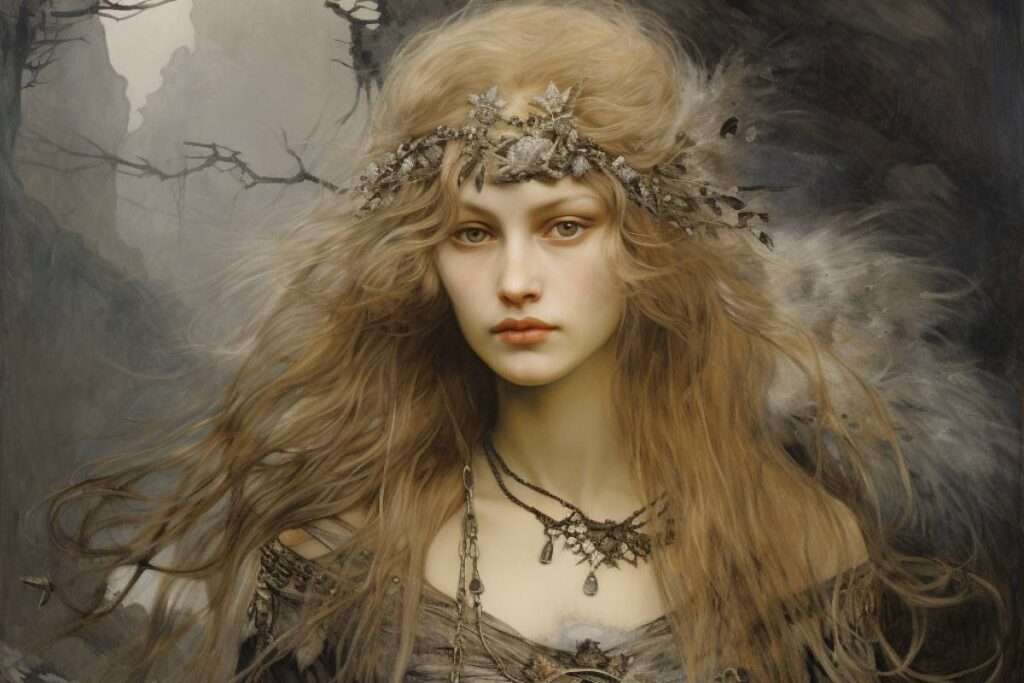Norse mythology, a rich tapestry of tales and beliefs from ancient Scandinavia, serves as a window into the worldview of the Vikings and their ancestors. Central to these myths is a pantheon of gods and goddesses, among whom Freyja stands out as a multifaceted deity. Revered as the goddess of love, beauty, fertility, war, and death, Freyja’s role in Norse mythology is as complex as it is influential. She is not just a figure of romance and allure but also a warrior and a guide to the afterlife, embodying a unique blend of life’s diverse aspects. This article aims to provide a detailed, accurate, and insightful exploration of Freyja, delving into her origins, significance, and enduring legacy in Norse mythology. By examining her multifaceted character and the narratives surrounding her, we will gain a deeper understanding of her role and the broader context of Norse mythical traditions.
| Origin | Norse Mythology |
| Deity Type | Goddess of Love, Beauty, and Fertility |
| Appearance | Often depicted as a beautiful and radiant goddess |
| Role | Goddess of love, beauty, sexuality, and fertility; associated with magic and war |
| Cats | Often accompanied by two cats, her sacred animals |
| Necklace | Possessed the Brísingamen, a prized and powerful necklace |
| Cultural Impact | A central figure in Norse mythology, symbolizing love and beauty |
| Depictions | Featured in many Norse myths and poems, revered by Vikings and Norse people |
1. The Origin and Family of Freyja
The Genesis of Freyja in Norse Lore
Freyja, a name that resonates with allure and mystique in Norse mythology, originates from the Vanir, a tribe of gods known for their connection with fertility, prosperity, and foresight. Unlike the Aesir gods, who are often associated with war and governance, the Vanir represent a different facet of the Norse cosmic order, emphasizing harmony with nature and the cycles of life.
Freyja’s Divine Kin: Freyr and Njord
Freyja is not an isolated figure in the Norse pantheon but is deeply intertwined with her family, particularly her twin brother Freyr and their father Njord. Freyr, like Freyja, is a deity linked to fertility, as well as to sunshine and rain, playing a vital role in ensuring the prosperity of the land. Their father, Njord, the sea god, further exemplifies the Vanir’s connection to natural elements, ruling over winds, sea voyages, and fish harvests. This familial trio symbolizes the interconnectedness of various aspects of life and nature in Norse belief.

Understanding the Vanir
The Vanir tribe, to which Freyja belongs, is often seen in contrast to the more familiar Aesir gods like Odin and Thor. This distinction is not just about the domains they govern but also reflects a deeper philosophical divergence in Norse mythology. The Vanir’s association with natural and life-giving forces contrasts with the Aesir’s focus on power, conquest, and order. Freyja, within this framework, embodies the essence of the Vanir – fertility, beauty, and the cyclical nature of life, offering a nuanced understanding of Norse divinity that balances the often tumultuous and heroic narratives of the Aesir.
2. Freyja’s Symbolism and Powers
Freyja: A Goddess of Many Facets
Freyja, in Norse mythology, is a deity of extraordinary complexity, embodying seemingly contradictory aspects such as love, beauty, fertility, war, and death. This multifaceted nature highlights the Norse understanding of the divine as encompassing a broad spectrum of human experiences. As the goddess of love and beauty, she influences romance and desire. Her role as a fertility goddess extends beyond human fertility to the fertility of the earth, underscoring her connection to nature and life. However, Freyja is not confined to nurturing aspects; she is also a formidable figure in war and death. She is a chooser of the slain, half of whom go to her hall, Sessrúmnir, in Fólkvangr, illustrating her integral role in the Norse conception of the afterlife.

Freyja’s Enchanting Attributes
Among the most captivating of Freyja’s attributes is her chariot, drawn by two cats, a testament to her enchanting and majestic nature. This unique mode of transport reflects her status and otherworldly power, setting her apart in the Norse pantheon. Cats, in Norse culture, symbolized mystery and magic, qualities intrinsically linked to Freyja.
The Brísingamen Necklace
One of Freyja’s most famous magical items is the Brísingamen necklace, a dazzling piece of jewelry that epitomizes her beauty and charm. The lore surrounding this necklace, including how she acquired it, often involves themes of desire, cunning, and the interplay of power among the gods. The Brísingamen necklace is not just an ornament but a symbol of Freyja’s own potency and the allure that she holds over gods and mortals alike.
3. Freyja in Norse Myths and Legends
The Quest for Óðr: A Tale of Love and Mystery
One of the most poignant myths involving Freyja is her relentless search for her husband, Óðr. This story is not just a tale of romantic longing but also one that highlights Freyja’s depth of emotion and determination. Óðr’s mysterious disappearance and Freyja’s subsequent journey across the world, weeping tears of gold, add layers of enigma and sorrow to her character. This legend not only illustrates her role as a goddess of love but also her vulnerability and enduring dedication, offering a more humanized perspective of the divine.

Freyja in the Æsir-Vanir War: A Catalyst for Peace
Freyja’s involvement in the Æsir-Vanir War, a pivotal event in Norse mythology, underscores her significance in the pantheon. This conflict between the two tribes of gods, the Aesir and the Vanir, eventually led to their unification. Freyja, along with her brother Freyr and father Njord, was sent to the Aesir as part of the peace agreement. Her presence among the Aesir, as a Vanir deity, symbolized the merging of different aspects and values, embodying the harmonious coexistence of contrasting forces.
Freyja’s Realm in the Afterlife: Fólkvangr
In Norse mythology, the afterlife is a complex and multifaceted concept, and Freyja plays a crucial role in it. Her hall, Sessrúmnir, located in the field of Fólkvangr, is where she receives half of those who die in battle, the other half going to Odin’s Valhalla. This division of the slain warriors between Freyja and Odin emphasizes her authority and influence in matters of death and the afterlife. Fólkvangr, as Freyja’s domain, is often depicted as a place of fertility and beauty, reflecting her association with life and growth, even in death. Her role in guiding souls to the afterlife demonstrates her integral role in the Norse understanding of mortality and immortality.
4. Freyja’s Cultural Impact and Legacy
Freyja’s Influence in Ancient Norse Society
Freyja, far more than a mythical figure, held a profound place in the daily lives and spiritual practices of the Norse people. Her domains of fertility, love, and beauty made her an essential figure in rituals and ceremonies, especially those related to marriage, childbirth, and agriculture. As a symbol of fecundity and prosperity, she was often invoked for blessings in these areas. Moreover, her association with war and death made her a deity respected by warriors, balancing the nurturing aspects of life with the harsh realities of Norse society.

Archaeological Insights into Freyja’s Worship
The worship of Freyja is not just documented in texts but is also evident in archaeological findings. Artifacts such as amulets, figurines, and temple remnants provide tangible evidence of her veneration. The frequent depiction of her symbols, like the cat and the Brísingamen necklace, in various Norse artifacts further underscores her significance. These archaeological discoveries, ranging from simple household items to elaborate temple structures, reflect the widespread and enduring nature of Freyja’s worship in the Norse world.
Freyja’s Enduring Legacy in Modern Culture
Freyja’s legacy extends well beyond the ancient Norse era into modern times. She continues to be a source of inspiration in various cultural expressions, from literature and poetry to art and music. In literature, she often appears as a symbol of nature’s power and beauty or as a complex character in retellings of Norse myths. In visual arts, her depictions capture her multifaceted nature, portraying her as both a figure of majestic beauty and a formidable warrior.In modern neopaganism, people revere Freyja as a goddess of fertility, love, and magic, and her influence is also notable. Her enduring appeal lies in her complexity, embodying a range of human experiences and emotions that continue to resonate with people across different cultures and epochs.
5. Freyja in Comparative Mythology
Parallel Deities: Freyja and Goddesses Across Cultures
Freyja’s characteristics resonate strikingly with deities in other mythological traditions, suggesting a common thread in the human conceptualization of divine femininity. For instance, Aphrodite from Greek mythology and Venus from Roman lore, both goddesses of love and beauty, share similarities with Freyja in their domains and influence over human emotions and relationships. Additionally, like Freyja, the Celtic Morrígan encompasses aspects of war and fate, reflecting a shared archetype of the warrior goddess across different cultures.
Exploring Indo-European Connections
The similarities between Freyja and other goddesses in Indo-European mythologies have led scholars to theorize about shared origins. These theories posit that as the Indo-European peoples spread across Europe and Asia, they carried with them a common set of myths and deities, which then evolved and diversified into the various pantheons known today. This shared heritage is evident in the overlapping characteristics and roles of these goddesses. For example, the concept of a powerful female deity who oversees both fertility and death is a recurring theme, underscoring the universality of certain human experiences and beliefs.
Understanding the Goddess Archetype
The comparative analysis of Freyja with other goddesses highlights the broader concept of the goddess archetype in human civilization. This archetype, transcending individual cultures and histories, represents a deep-rooted aspect of human psychology and societal norms. It embodies the duality of nature and human experience, encapsulating creation and destruction, love and war, beauty and power. Freyja, in this context, is not just a figure of Norse mythology but a representation of a universal archetype that has manifested in various forms across different cultures and eras.

6. Conclusion
In conclusion, Freyja plays a pivotal role in Norse mythology, embodying a wide range of themes, from love and beauty to war and death. Her multifaceted nature mirrors the complexity of the Norse worldview, where deities encompassed diverse human experiences. As a fertility goddess, lover, warrior, and guide to the afterlife, she profoundly influenced ancient Norse society and culture. In the broader context of Norse culture, Freyja symbolizes the intertwining of life’s aspects, from nurturing nature to survival and conflict. Her enduring legacy in modern culture and parallels with deities in other mythologies highlight her universal appeal. Freyja stands as a testament to the enduring power of myth in understanding the human experience.
